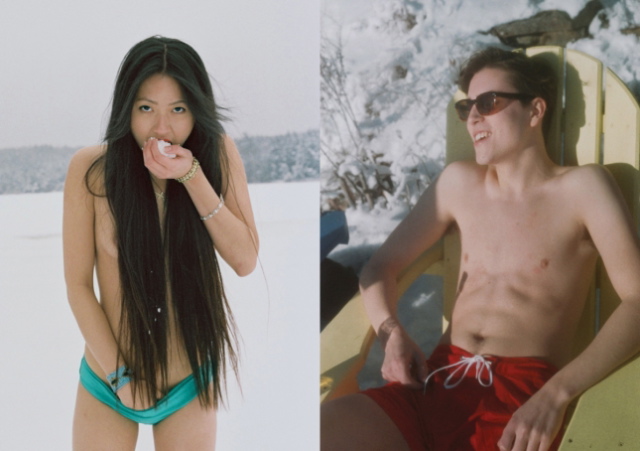
| The first two photos are taken from a shoot called "Fuck Winter," by photographer Petra Collins. The photos in this series depict men and women dressed in their underwear or swimsuits in the snow. The ways in which the woman and man are shown differ greatly. The woman is posed in a sexually compromising way. Her gaze is demanding, unlike than the man's. She is almost completely naked and eating snow. The lighting in this photo is also colder, harsher and starker. Her black hair and underwear are perhaps the most salient aspects of this photo, thus emphasizing her gender and femininity. The male counterpart is relaxing on a deck chair with a warm light cast over his body and a much softer camera focus. He is smiling, unlike the woman, and is looking away from the camera. It is important to also note that the female model is non-white, unlike the male. The most salient aspects of this photograph are the model's red swimming trunks and also the sunglasses. The articles of clothing are the emphasis in this photograph and much less emphasis is placed on the male's body. The expression of gender is decidedly different from that of the 'party shots.' Because fashion is positioned very directly within consumerism and capitalism, it could be that Vice is following more a more heteronomative discourse of gender identity expression. |  |
 |
The third image is from a series called "Playdating" by Masha Mel. It shows a young, African American female whisking what appears to be cake batter. She is scantily clad and is also looking directly at the camera, but she is positioned in a less vulnerable and overtly sexual way than the previous model. The photographs in this series lack the sharpness of the first two and look as if they have been taken with a film camera. The intention to produce an older-looking image could be a conscious artistic choice on the part of the photographer to create a sense of nostalgia. The model as engaging in baking frames and interpellates her within a particular domestic context. This concept of nostalgia presents an alternative visuality from the typical high-resolution, glossy images of most fashion magazine. Just as the previous images challenges expectations of setting by showing exposed bodies in extreme cold, this image transgresses the role of technology in fashion photography by utilizing a 'amateur' mode of production. Fashion photos that are blurry or lack focus also have the potential to obscure the semiotic meaning of the photograph rather than a sharp image (Rollins, 131). The choice to create a more visually unclear image could also be a way to re-contextualize the meaning of a sexualized woman in a domestic space. The photograph's use of nostalgia could be communicating something about traditional conceptions of heternormativity, but the level of self-awareness in this choice is impossible to know for sure. |